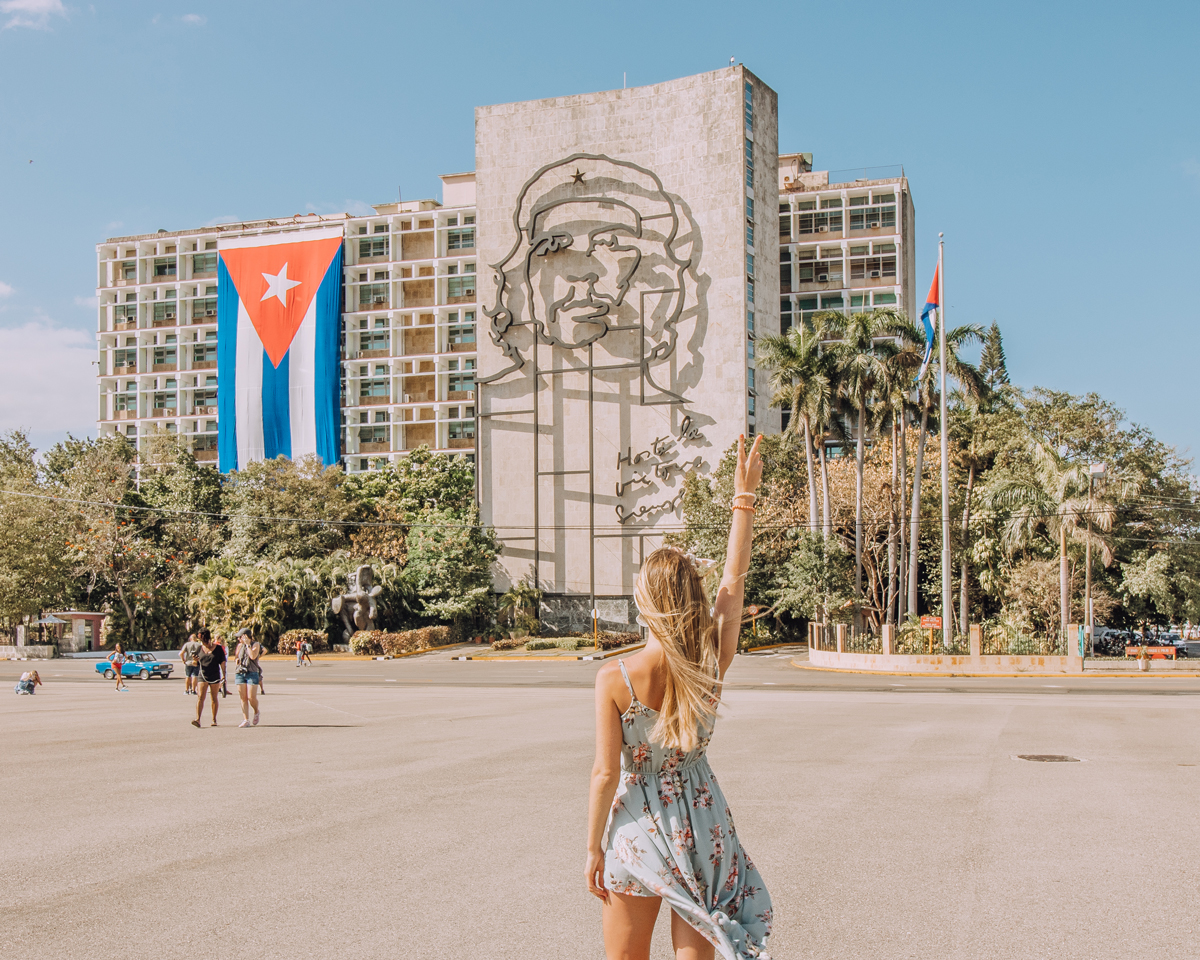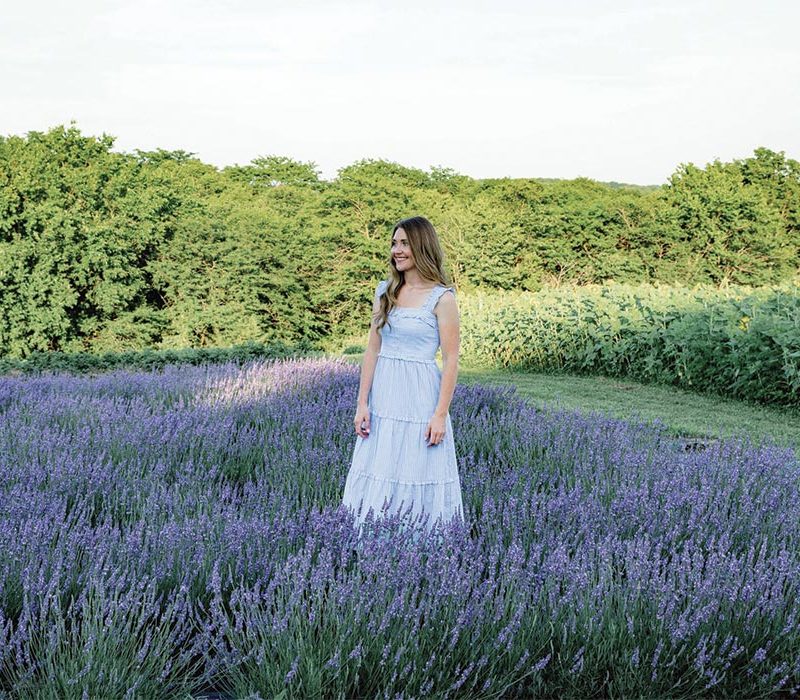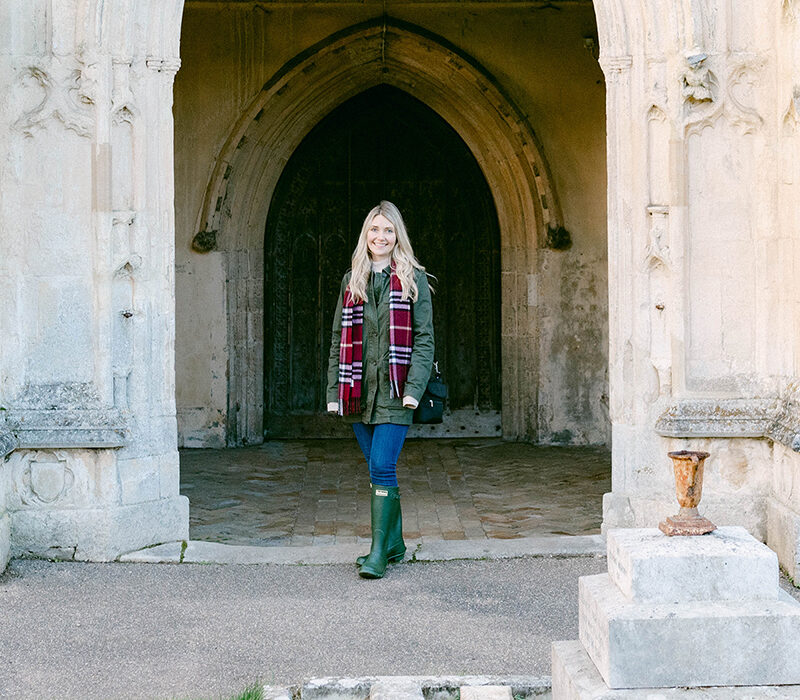Many passengers on my plane were Cuban Americans on their way to visit their family and friends. However, there were a few people like myself who were visiting on a Support for the Cuban People visa. Many people were bringing suitcases full of necessities (items that are otherwise restricted by the U.S. embargo) to their loved ones.
A young man sat next to me on the plane. He was on his way to visit his girlfriend and daughter, and he was bringing a suitcase full of toys with him. He was Cuban American, and his girlfriend was Cuban – parents separated by two governments and 90 miles of ocean.
 Pictured above: Me standing in Revolution Square, Havana, Cuba – photo by my cousin, Suzie.
Pictured above: Me standing in Revolution Square, Havana, Cuba – photo by my cousin, Suzie.
Curious about Cuban Culture
I was originally drawn to Cuba by my love for history and photography. What I found was so much different than what I expected. It took two trips to Cuba for me to begin to see that there was a much deeper story. The Cuba presented in travel magazines, is very much a Cuba you can experience on organized tours. But it is not the real Cuba – the Cuba the citizens experience every day is much harder than you can even imagine.
I left Cuba with love and respect for its people and their beautiful culture; their dance, music, art, performance, and mostly their kindness.
The Lure of Cuba
Cuba is a glimpse of the past in the living present, making it like few other places in the world.
Classic American cars drive up and down the Malecon as ocean waves crash against the rocks. The intricate details of the baroque-style mansions were abandoned and left to the elements to decay, reminding you of the money that once existed here. Walking around Havana today is like walking around with ghosts from Cuba’s past. The last days of democracy are permanently stamped in the architecture of these buildings, in the cars on the streets, and forever on the people’s faces. While this time capsule makes people from outside curious about Cuba, it is where the story gets personal and painful for many people on both sides – Cuba and the U.S.
I spent hours digging into Cuba’s history before I left home. I researched the Castro brothers, John F. Kennedy, the embargo, and all the years of bad blood between the two countries. The more I read, the more my heart ached. I could not understand why, so many years later, our relationship with Cuba remains broken.
I realized I had to further educate myself on the history of both sides of this complex story. I had to hear from the people themselves. I knew that my main goal in traveling to Cuba was to talk to real people about their experiences and to document their stories.
Corruption, the Mafia and Castro
In Cuba during prohibition and up until the early 1950s, gambling and crime ran rampant through the country. American and Italian mafia met in Havana, where they worked directly with Cuba’s president, Fulgencio Batista, to control casinos across the island. Cuba was a playground for the wealthy. Many wealthy Cubans owned sugar cane plantations in the Cuban countryside and mansions in Havana. But all that was about to change. A series of gorilla attacks unfolded in the mountains in Cuba that was lead by Fidel Castro, his brother, Raul, and their friend, Che Guevera. After a few failed attempts, the three men and their army overthrew president Batista and the mafia to begin what they would call, “The Revolution”. 1
Castro’s first mission was to reclaim Cuban land from the wealthy and disperse it back to the farmers. He began taking sugar mills, distilleries, and factories from their owners. This did not sit well with those American business owners and the U.S. government.
President Dwight D. Eisenhower imposed the first embargo on Cuba to cover all U.S. exports to the country. A few years later in 1962, President John F. Kennedy revised the embargo to include all Cuban imports to the U.S., and it was deemed that the embargo may only be removed through an act of congress.2
Cuban landowners, actors, singers, and writers, including Ernest Hemingway, fled the island and never returned to their homes. The homes were abandoned and sometimes left to servants. Families were separated. Many parents sent their children to the U.S. for safety but weren’t reunited for decades. Others were never reunited with their loved ones. 3
Ships filled with people sailed to Florida, to never return, and time stopped in Cuba.
With all ties cut from the U.S. under the new embargo, Castro situated Cuban trade with the Soviet Union in order to keep its economy afloat, further sealing Cuba’s fate with the U.S.
When the Soviet Union collapsed in the early 1990s, Cuba began to face the most devastating period on the island. They had little to no resources. Food rations were scarce, and many people starved. Cuba was forced to find new means for survival. 4
The embargo on trade between the U.S. and Cuba continues to this day. Sadly, the people left to feel the grip of the embargo are young Cubans and Cuban Americans, many of whom weren’t even alive during Batista’s time. They are people like the young man who sat next to me on the airplane with a suitcase full of toys for his daughter.
Food for Thought
I took lessons from my visit that I would have only gotten from Cuba. I saw people giving birth to some of the most creative, vibrant works of music, art, and theatre I’ve ever seen. I saw talent perfected in the midst of pain, caused by oppression.
And while we may not individually be able to fix the past or mend the wounds, there are a few things we can do today to help. And that starts with research and a visit to Cuba, so you too can hear from the locals and truly support the Cuban people. If you decide to visit, please consider donating supplies.
Donating to Cubans
It is very hard for many Cubans to have even enough basic necessities and products are very expensive in relation to their incomes. If you’re headed to Cuba and you’d like to know about taking donations with you, some things you might consider are clothes, toiletries, and hygiene products. If you have any questions, please feel free to contact me.
-xo
Steph
1 The Cuba Libre Story, season 1, 2015.Netflix, https://www.netflix.com/title/80109535
2 http://time.com/4076438/us-cuba-embargo-1960/
3 https://www.npr.org/2011/11/19/142534943/pedro-pan-childrens-life-altering-flight-from-cuba
4 Cuba and the Cameraman, 2017.Netflix, https://www.netflix.com/title/80126449



Thank you for the history, perspective and reflection, Caleb and I ourselves have discovered that traveling is so much more than a “vacation” away from home…it’s an expansion of our personal bubble, our hearts and minds, and a way to connect with the world around us in ways we are limited by in our day to day…this echoes that for me <3
It’s so true, traveling gives us beautiful unexpected moments that make us pause, think, and reflect. <3
Thanks for your support, girl. Cheers to travel!